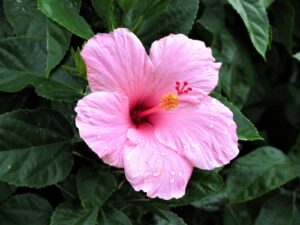With their vibrant colors and tangy-sweet taste, hibiscus flowers are growing in popularity. But many people wonder – what does hibiscus taste like? This article will explore the flavor profile of hibiscus, how it is used, and the health benefits it provides.
Table of Contents
An Introduction to Hibiscus Flowers
Hibiscus flowers come from the Hibiscus sabdariffa plant native to Africa. Some key facts about hibiscus:
- Over 300 hibiscus species exist around the world, but Hibiscus sabdariffa is most widely used.
- The red calyxes (sepals) surround the flowers and are harvested for use.
- Hibiscus is made into teas, natural health products, beverages, jams, and used as a food garnish.
- It offers a tangy cranberry-like flavor along with health benefits.
- Hibiscus grows in tropical and subtropical regions but the flowers are exported worldwide.
Next let’s examine the taste and aroma that makes hibiscus unique.
What Does Hibiscus Taste Like? Flavor Profile Explained
Hibiscus has a tart, cranberry-like taste, often described as sweet yet sour. There are also subtle fruity, floral notes. More specifically, hibiscus exhibits:
- Bright, vibrant acidity reminiscent of cranberries
- Hint of sourness that puckers the mouth slightly
- Sweet, fruity overtones ranging from berries to citrus
- Subtle rose-like aromatics
- Occasional bitter note depending on age of the flower
- Astringent drying sensation similar to black tea
When brewed into tea, hibiscus has a gorgeous deep magenta color. The flavor is tart but not overwhelmingly sour, making it palatable both hot and iced.
How Hibiscus Compares to Other Plants
To better understand hibiscus, it helps to contrast it with other herbs and flowers:
Cranberries
- Taste: Very close to cranberries – bright red-fruit acidity.
- Aroma: Cranberries lack hibiscus’s subtle floral note.
- Use: Mostly used dried or juiced rather than fresh like hibiscus.
Rose Hips
- Taste: Rose hips run tart too but have more subtle berry flavors.
- Aroma: Hibiscus has a stronger rose fragrance.
- Use: Rose hips not typically eaten fresh.
Hibiscus vs Pomegranate
- Taste: Similarly tart but pomegranate is seedier, less floral.
- Aroma: Hibiscus has a rose note, pomegranate more fruity.
- Use: Pomegranates not eaten fresh as often as hibiscus flowers.
Roselle
- Taste: Very similar bright sour-sweet profile. Roselle is another name for Hibiscus sabdariffa.
- Aroma: Identical floral-fruity aromatics.
- Use: Interchangeable – both are harvested from the same plant.
How to Eat Hibiscus Flowers
There are many ways to enjoy the tangy flavor of hibiscus:
- Tea – Most popular use, often blended with other herbs. Brew dried or fresh petals.
- Jams and jellies – Adds nice acidity balanced by sugar.
- Salads – Fresh petals provide a citrusy kick.
- Cocktails – Muddled fresh hibiscus makes tasty margaritas and daiquiris.
- Sorbets – Vibrant magenta color with tangy zing.
- Syrups – Sweetened hibiscus simple syrup dresses up beverages.
- Baking – Extracts add pretty color and floral-berry taste.
The flowers and dried calyxes provide the best flavor. Consume in moderation as very high doses may cause stomach upset.
What Foods and Drinks Complement Hibiscus
Hibiscus’s tartness pairs well with:
- Tropical fruits – pineapple, mango, guava, coconut
- Citrus – especially lime, neutralizes some sourness
- Herbs – mint, basil, lemon verbena
- Sweeteners – honey, agave, cane sugar
- Rum, tequila, gin – enhances hibiscus’s use in cocktails
- Yogurt, ice cream – dairy soothes the tart edge
- Chili pepper – contrasting heat and acidity
When using hibiscus, balance its assertive tanginess with sweet and creamy ingredients.
Health and Nutrition Benefits of Hibiscus
In addition to its bright flavor, hibiscus offers many health benefits:
- Excellent source of vitamin C and antioxidants
- Polyphenols linked to lowered blood pressure
- May boost liver health and reduce fat storage
- Anti-inflammatory and antimicrobial properties
- Potential anticancer effects being researched
- Provides nutritious flavonoids like anthocyanins
Drinking hibiscus tea offers a great way to hydrate while gaining protective compounds.
Key Takeaways About Hibiscus Taste and Uses
To recap, here are the key points about hibiscus flavor:
- Hibiscus tastes tart and sour like cranberries, with subtle sweet berry and floral notes. It makes a vibrantly hued tea.
- It compares closely to cranberries and rose hips but offers stronger rosy aromatics. The flavor pairs well with tropical fruits and citrus.
- Fresh flowers can be used in salads or muddled into cocktails. Dried hibiscus shines in teas, jams, sorbets and syrups.
- Hibiscus flowers contain vitamin C, antioxidants, and anthocyanins that deliver numerous health benefits.
- With a pleasing cranberry-like tartness and gorgeous color, edible hibiscus flowers lend themselves to many drinks and dishes.
So for those seeking a flavor that is intensely tart yet nuanced, give the delicate hibiscus flower a taste.


